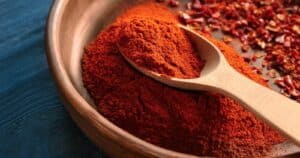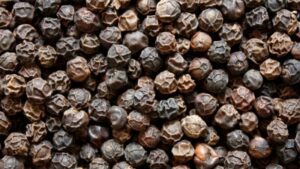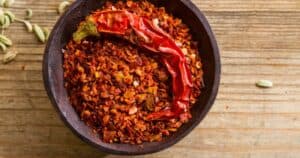With their fruity flavor and fiery heat, scotch bonnet peppers can really
If you’re a
Here’s what you should know about the potential consequences of scotch bonnet overindulgence:
- They contain very high levels of capsaicin, which can provoke nausea, stomach pain, vomiting, and diarrhea when consumed excessively.
- Capsaicin can also cause burning eyes and nose, flushed skin, sweating, and more discomfort.
- Allergic reactions are rare but possible. Inhaling capsaicin can trigger asthma flares too.
- Side effect severity depends on the amount eaten and individual tolerance. Seek medical attention for persistent issues.
The good news? By using scotch bonnets wisely and in moderation, you can safely enjoy their tropical zing.
Ready to learn more about strategically harnessing scotch bonnets’ heat while avoiding the side effects? Keep reading for tips on proper prep, storage, and indulgence of these fiery peppers.
What Makes Scotch Bonnets So Hot?
Here’s the deal – scotch bonnets contain a powerful compound called capsaicin. It’s what gives all chili peppers their characteristic heat and piquancy.
Capsaicin tricks your nerves into feeling like your mouth is on fire. It binds to pain receptors and triggers that intense burning sensation.
Now, here’s the kicker – scotch bonnets contain exceptionally high levels of capsaicin compared to most other peppers.
This makes their heat downright hellacious. Just a tiny amount packs a blistering punch.
So what happens if you eat too many of these fiery fruits? Read on to find out.
Is It Safe to Eat a Whole Scotch Bonnet Pepper?
Scotch bonnets are so searingly hot that eating a whole one raw is an endeavor only the boldest should attempt.
Here’s what you should know about taking on a complete scotch bonnet:
- With up to 350,000 Scoville units, scotch bonnets can be over 100 times hotter than a jalapeño.
- Eating an entire pepper places a very concentrated dose of capsaicin on your tastebuds and digestive tract.
- This is likely to cause significant oral, throat, and stomach burning, nausea, sweating, and other unpleasant side effects.
- The intensity and duration of discomfort will depend on your individual
spice tolerance. - Having milk, yogurt, bread, and antacids on hand can help tame the flames.
- It’s possible to build up a tolerance to scotch bonnet heat, but start slowly. Don’t jump straight to eating a whole one.
In summary, consuming a whole, raw scotch bonnet is an extreme challenge even for die-hard chili-heads. While not necessarily dangerous, the resulting fire and regret may not be worthwhile. Proceed with caution!
Consuming Too Many Scotch Bonnets Can Cause Issues
While one or two slivers of scotch bonnet add pleasant fire to your food, going overboard is unwise.
Eating too many scotch bonnets or dishes dense with their flesh and juices can provoke some painful side effects.
Potential consequences of scotch bonnet overindulgence include:
- Intense burning sensation in mouth, throat, and stomach
- Nausea and vomiting
- Abdominal cramps and pain
- Diarrhea
- Flushed or sweaty skin
- Runny nose and eyes
Not a pretty picture! Clearly, caution is key with scorching scotch bonnets.
Capsaicin: The Culprit Behind the Burn
The capsaicin contained in scotch bonnets causes this cavalcade of misery when consumed excessively.
Here’s a look at how capsaicin wreaks havoc:
- It inflames sensitive mucus membranes in the eyes, nose, mouth, throat, stomach, and intestines.
- It irritates nerve endings that detect pain and heat, making your brain think you’re burning up.
- It stimulates the release of stomach acid, leading to indigestion.
- It increases bowel motility, causing diarrhea.
Bottom line: capsaicin overload equals agony.
Other Risks: Allergies, Asthma, and Contamination
For some folks, even tiny amounts of scotch bonnets pose problems:
- Allergies: Capsaicin allergies, though rare, cause hives, swelling, and anaphylaxis.
- Asthma: Inhaling airborne capsaicin particles can trigger asthma attacks.
- Contamination: Raw scotch bonnets may harbor foodborne pathogens like salmonella.
So check with your doctor if you have special sensitivities before indulging.
Tips for Safely Enjoying Scotch Bonnets
Luckily, savoring scotch bonnets safely simply requires a bit of common sense:
- Use extreme moderation – a little sauce or a sprinkle of diced pepper goes a long way.
- Wear gloves when handling raw peppers to avoid skin burns.
- Wash hands, utensils, and cutting boards after use to avoid inadvertent contact.
- Cook scotch bonnets thoroughly to kill any pathogens.
- Start with a small taste if trying a new scotch bonnet dish.
- Have milk, yogurt, bread, and antacids available to tame the flames if needed.
- Avoid serving ultra-spicy dishes to those with sensitivities.
Follow these best practices and you can delight in scotch bonnets without the dire distress!
Creative Ways to Cook with Scotch Bonnets

Looking for inspirational yet prudent ways to cook with scotch bonnets? Here are some tasty recipe ideas:
- Jerk chicken or pork: Use 1-2 diced scotch bonnets in the marinade.
- Fiery fish tacos: Add a few drops of scotch bonnet hot sauce to the slaw.
- Caribbean rice and peas: Stir in 1-2 tablespoons of finely minced scotch bonnet.
- Mango scotch bonnet salsa: Start with just half of a pepper and add more if needed.
- Scotch bonnet hot sauce: Blend peppers into a vinegar base for a customizable condiment.
- Curries and stews: Know your crowd’s heat tolerance and adjust the number of peppers accordingly.
- Scotch bonnet cornbread: Mix a dozen mini-diced peppers into the batter for a slow burn.
- Scotch bonnet pepper jelly: Process peppers into a sweet jelly to spread on biscuits, toast, and crackers.
No matter the recipe, remember to start small. Add more scotch bonnet as needed, but overdoing it can lead to misery. Apply the “you can always add more but can’t take it out” motto.
What to Do if You Overdo It on Scotch Bonnets
Uh oh. Despite your best intentions, you accidentally went overboard on scotch bonnets. Now what?
First, don’t panic. The burning will pass. Here are some tips to find relief:
- Drink milk, eat yogurt, or suck on ice cubes. Casein protein in dairy helps wash capsaicin away.
- Avoid drinking water, as capsaicin isn’t water-soluble. It will just spread the heat.
- Take an antacid containing magnesium hydroxide or aluminum hydroxide. These buffer stomach acid.
- For diarrhea, stay hydrated with electrolyte drinks.
- For severe reactions, seek medical care. IV fluids may be administered.
Lay off the scotch bonnets for a while after an overdose until your body recovers!
The Takeaway on Scotch Bonnet Side Effects
Scotch bonnets contain sky-high amounts of the potent compound capsaicin. This gives them their extreme, blistering heat.
Consumed in moderation, they add welcomed fire to recipes. But eat too many, and you may suffer the burn both in and out.
Exercise caution when cooking with scotch bonnets, and you can safely reap their tropical heat and dynamic fruity flavor.
Just remember – when it comes to scorching scotch bonnets, less is often best! With reasonable and wise use, you’ll avoid the misery.





